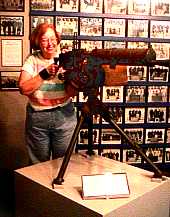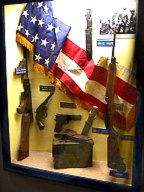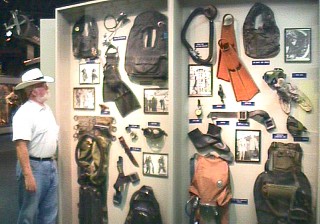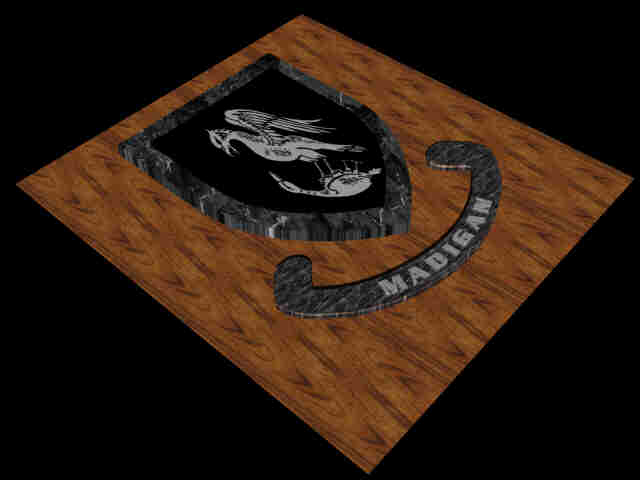The training would pay off
during operations in combat theaters. Scout and Raider personnel,
though  small in number, would participate in many
worldwide amphibious landings. They guided assault landing craft
in the Mediterranean and South Pacific; made hydrographic
reconnaissance of Italy, France and the Pacific, and landed on
Normandy to confirm the usefulness of the beaches. They operated
together to provide information to invasion commanders and
wartime leaders. The Navy and Army personnel of this unit were an
outstanding example of the cooperative nature of modern warfare;
small numbers of sailors and soldiers specially trained to
accomplish common goals. These NCDUs, UDT and S&Rs organized
to handle all phases of warfare to take them from their ships to
the beach. One such tool, on hand was the U.S. Model 1917A1
machine gun which was a typical armament for the landing craft
they had to pilot in close range of the enemy. Heavier fire
support came from supporting ships farther out, including
destroyers and cruisers. The NCDU sailors landed on Utah Beech in
Normandy to participate in Operation Dragoon, the invasion of
southern France in August 1943. Their operations were quite
different from the earlier landings. They attempted to use a
technique new to the European Theater; pushbutton warfare. Their
task and that of many other NCDUs at Normandy was to clear boat
channels through the mines and
small in number, would participate in many
worldwide amphibious landings. They guided assault landing craft
in the Mediterranean and South Pacific; made hydrographic
reconnaissance of Italy, France and the Pacific, and landed on
Normandy to confirm the usefulness of the beaches. They operated
together to provide information to invasion commanders and
wartime leaders. The Navy and Army personnel of this unit were an
outstanding example of the cooperative nature of modern warfare;
small numbers of sailors and soldiers specially trained to
accomplish common goals. These NCDUs, UDT and S&Rs organized
to handle all phases of warfare to take them from their ships to
the beach. One such tool, on hand was the U.S. Model 1917A1
machine gun which was a typical armament for the landing craft
they had to pilot in close range of the enemy. Heavier fire
support came from supporting ships farther out, including
destroyers and cruisers. The NCDU sailors landed on Utah Beech in
Normandy to participate in Operation Dragoon, the invasion of
southern France in August 1943. Their operations were quite
different from the earlier landings. They attempted to use a
technique new to the European Theater; pushbutton warfare. Their
task and that of many other NCDUs at Normandy was to clear boat
channels through the mines and  obstacles lining the beaches. These cleared
slots were then used to land troops and equipment. Going in first
at Omaha Beach they came under the most intense fire. Their
heroic efforts were instrumental in the success of the landing,
but more than half of them were killed or wounded. The central
Pacific area had unique problems unlike any other theater of
World War II. U.S. forces learned the hard way that taking
strategically vital islands from Japan would be a long and
expensive job. The U.S. experience began with Tarawa atoll. The
November 1943 invasion was the first in atoll warfare.
obstacles lining the beaches. These cleared
slots were then used to land troops and equipment. Going in first
at Omaha Beach they came under the most intense fire. Their
heroic efforts were instrumental in the success of the landing,
but more than half of them were killed or wounded. The central
Pacific area had unique problems unlike any other theater of
World War II. U.S. forces learned the hard way that taking
strategically vital islands from Japan would be a long and
expensive job. The U.S. experience began with Tarawa atoll. The
November 1943 invasion was the first in atoll warfare.  The
Japanese made special efforts to protect the islands, using
natural and man-made barriers to fortify the island as much as
possible against attackers. They hid in bunkers of concrete,
coconut palms and sand difficult to penetrate. Many Marines and
soldiers lost their lives fighting nearly three days to take
islands less then a square-mile in size. The U.S. commanders,
unaccustomed to the new type of war, made mistakes that cost many
lives. No reconnaissance had been done on the lagoon or the
beach, most information dated from the 1800s. Pre-assault gunfire
support was minimal. Commanders relied on tide and beach data
based on aerial photographs rather then actual reconnaissance.
The operation's commander, Adm. R. K. Turner, learned bitter
lessons. The most important, was to make the critical beach
assault as smooth as possible with better reconnaissance for
planning and use demolition to get landing craft close to the
beach. He asked to establish special Navy units to do this
mission. This resulted in the formation of the
The
Japanese made special efforts to protect the islands, using
natural and man-made barriers to fortify the island as much as
possible against attackers. They hid in bunkers of concrete,
coconut palms and sand difficult to penetrate. Many Marines and
soldiers lost their lives fighting nearly three days to take
islands less then a square-mile in size. The U.S. commanders,
unaccustomed to the new type of war, made mistakes that cost many
lives. No reconnaissance had been done on the lagoon or the
beach, most information dated from the 1800s. Pre-assault gunfire
support was minimal. Commanders relied on tide and beach data
based on aerial photographs rather then actual reconnaissance.
The operation's commander, Adm. R. K. Turner, learned bitter
lessons. The most important, was to make the critical beach
assault as smooth as possible with better reconnaissance for
planning and use demolition to get landing craft close to the
beach. He asked to establish special Navy units to do this
mission. This resulted in the formation of the  Underwater
Demolition Teams. The last combat action of UDTs in the three
year long Pacific campaign occurred on the southwest Pacific
Island of Borneo. The Japanese held on to this oil rich area
stubbornly as the Allies fought closer to Japan and cut it off
from vital resources. The Frogmen guided Australian troops to
this final combat engagement. Team 11 and 18 joined the NCDUs
which had fought throughout the southwest Pacific. They
discovered some of the toughest resistance of the Pacific War.
The Japanese had sown thousands of mines to keep the Allies from
landing, planting logs and steel rails along the beaches. They
also blew up oil refineries and pumping stations casting a pall
of oily smoke over the landing area. Under heavy defensive fire,
Frogmen and demolitioneers blew 800 yard wide gaps in landing
areas allowing the Australian troop to land safely. The efforts
of the UDT and
Underwater
Demolition Teams. The last combat action of UDTs in the three
year long Pacific campaign occurred on the southwest Pacific
Island of Borneo. The Japanese held on to this oil rich area
stubbornly as the Allies fought closer to Japan and cut it off
from vital resources. The Frogmen guided Australian troops to
this final combat engagement. Team 11 and 18 joined the NCDUs
which had fought throughout the southwest Pacific. They
discovered some of the toughest resistance of the Pacific War.
The Japanese had sown thousands of mines to keep the Allies from
landing, planting logs and steel rails along the beaches. They
also blew up oil refineries and pumping stations casting a pall
of oily smoke over the landing area. Under heavy defensive fire,
Frogmen and demolitioneers blew 800 yard wide gaps in landing
areas allowing the Australian troop to land safely. The efforts
of the UDT and  NCDUs in Borneo earned UDT 11, the Presidential
Unit Citation. The Navy awarded only two other demolition units
this high honor during the war. the NCDUs who fought at Normandy
in 1944 and UDT 12 for heroism at Iwo Jima and Okinawa. The Navy,
in doing so, showed its high respect for this new profession and
planned to count on it for helping to finish the war. The Korean
"police action" was a hard fought war to contain
Communism.
The Korean War was the first test of the Truman Doctrine in an
actual conflict. The Navy's role was characterized by the extreme
climates of the region. Intense cold winters, blistering hot
summers and radically changing tides made the Korean War an
experience for soldier, sailor and airman alike. The UDTs while
operating in much smaller numbers than in World War II, played an
important role in the action.
NCDUs in Borneo earned UDT 11, the Presidential
Unit Citation. The Navy awarded only two other demolition units
this high honor during the war. the NCDUs who fought at Normandy
in 1944 and UDT 12 for heroism at Iwo Jima and Okinawa. The Navy,
in doing so, showed its high respect for this new profession and
planned to count on it for helping to finish the war. The Korean
"police action" was a hard fought war to contain
Communism.
The Korean War was the first test of the Truman Doctrine in an
actual conflict. The Navy's role was characterized by the extreme
climates of the region. Intense cold winters, blistering hot
summers and radically changing tides made the Korean War an
experience for soldier, sailor and airman alike. The UDTs while
operating in much smaller numbers than in World War II, played an
important role in the action.
